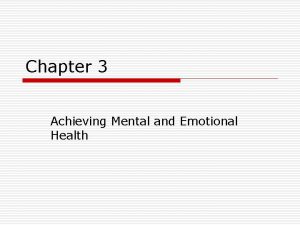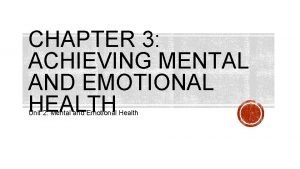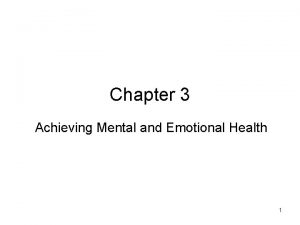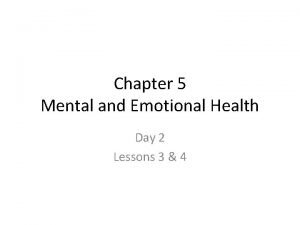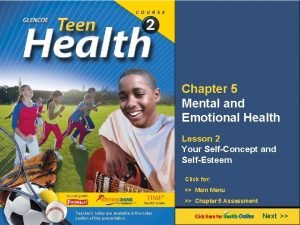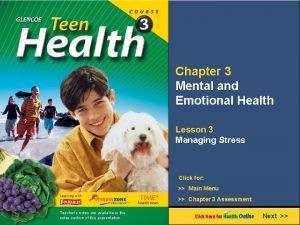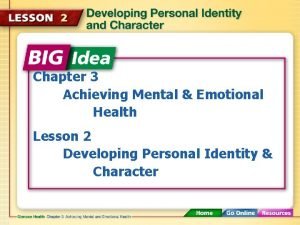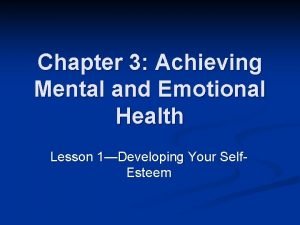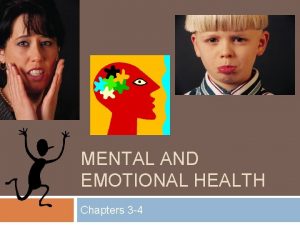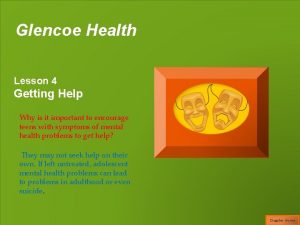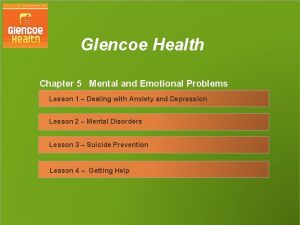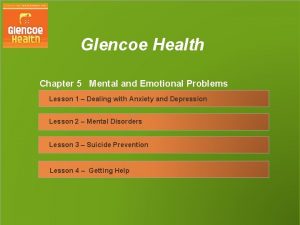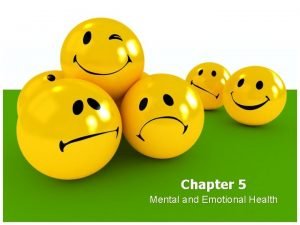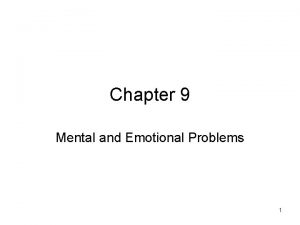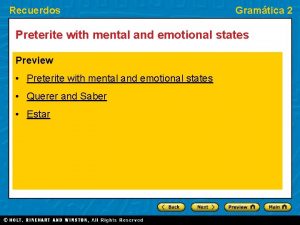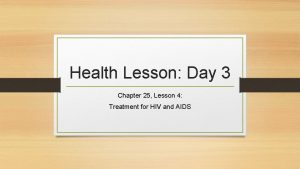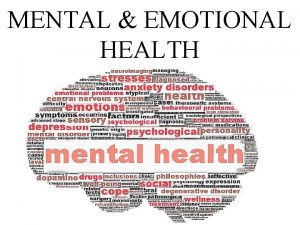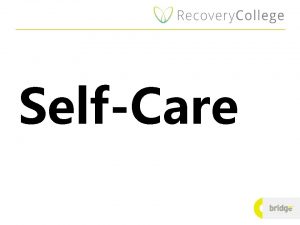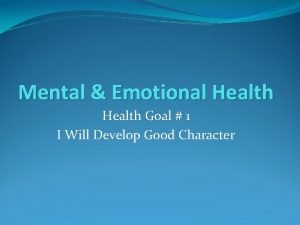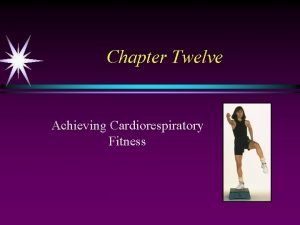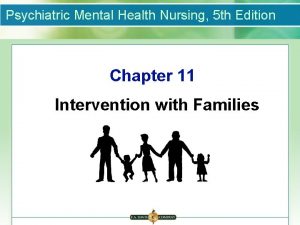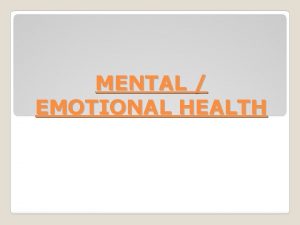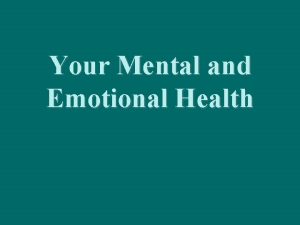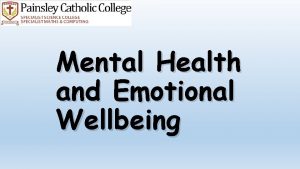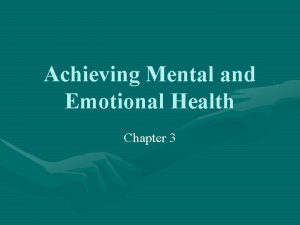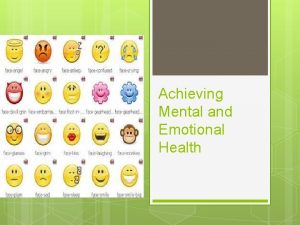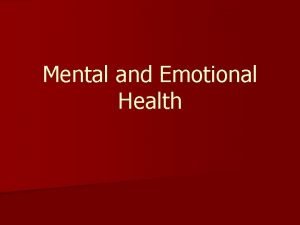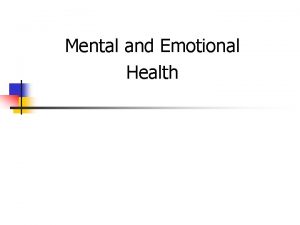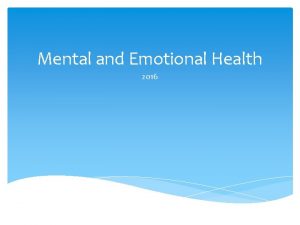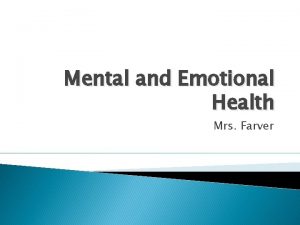Chapter 15 Achieving Mental and Emotional Health Lesson






































- Slides: 38

Chapter 15 Achieving Mental and Emotional Health Lesson 15. 1 15. 2 15. 3 15. 4 Making Sense of Your Emotions Establishing Your Identity Understanding Self-Esteem Improving Your Mental and Emotional Health

Lesson 15. 1 Making Sense of Your Emotions

Warm-Up Emotional Health What does it mean to have high emotional intelligence? Is high emotional intelligence the same as high self-esteem? thinkstock. com/Digital Vision Copyright Goodheart-Willcox Co. , Inc. May not be posted to a publicly accessible website.

Understanding Emotions • Emotions are the moods or feelings you experience • Figuring out which emotions you feel and why can be difficult – EX: try out for the team & you don’t make it. . you get angry w/coach when the anger is hiding your feelings of sadness. • Both pleasant and unpleasant emotions are part of daily life – Unpleasant: anxiety, jealousy, guilt, stress, depression – Pleasant: joy, gratitude, love, pride, etc. shutterstock. com/miya 227 Copyright Goodheart-Willcox Co. , Inc. May not be posted to a publicly accessible website.

Managing Emotions • First, identify the emotions you are feeling • Second, try to acknowledge and accept the emotions • Third, express your emotions • Finally, find a way to make yourself feel better shutterstock. com/Aleksandr Markin Copyright Goodheart-Willcox Co. , Inc. May not be posted to a publicly accessible website.

Critical Thinking Expressing Emotions You should remember not to hurt someone, or yourself, when expressing emotions. What are some guidelines you can follow to help you express your feelings without hurting others? Copyright Goodheart-Willcox Co. , Inc. May not be posted to a publicly accessible website.

Develop Resilience and Coping Skills • Disappointments, rejections, and mistakes are a normal part of life • Feeling sad, anxious, and frustrated during these times is normal • Developing coping skills can help you get through the more difficult times shutterstock. com/Andi Berger Copyright Goodheart-Willcox Co. , Inc. May not be posted to a publicly accessible website.

Think Further What are some characteristics of people who cope well with emotional difficulties? – These people have Optimism (ability to keep a positive outlook) • They know they will feel better • They are flexible and adapt, change, and grow as they encounter different life experiences – They show Resilience (ability to recover from traumatic and stressful situations) • They work through their emotions in a positive way Copyright Goodheart-Willcox Co. , Inc. May not be posted to a publicly accessible website.

Emotional Intelligence • People with high emotional intelligence can identify the emotions they are feeling • They also understand the emotions of others • They have high levels of empathy (the ability to put themselves in someone else's shoes) • They are able to express their emotions in healthy, positive ways shutterstock. com/Elena Elisseeva Copyright Goodheart-Willcox Co. , Inc. May not be posted to a publicly accessible website.

Emotional Intelligence • People with High Emotional Intelligence exhibit: – Self-awareness • Understand their emotions and how their emotions impact people around them – Self-regulation • They can control their feelings and impulses and act with careful deliberation and integrity. – Motivation • They are willing to work on challenging tasks and are highly productive – Social Skills • Work well with others, help build and maintain relationships, and resolve conflicts in constructive ways shutterstock. com/Elena Elisseeva Copyright Goodheart-Willcox Co. , Inc. May not be posted to a publicly accessible website.

Lesson 15. 2 Establishing Your Identity

Forming an Identity • Your identity includes – Physical identity • Gender, race, age, physical characteristics, such as height, weight, and hair color – Active identity • Engagement in particular activities and interests, such as sports, music, and community services shutterstock. com/Rob Byron Copyright Goodheart-Willcox Co. , Inc. May not be posted to a publicly accessible website.

Forming an Identity – Social identity • Connection to other people, including family members, friends, and group members – Psychological identity • Internal thoughts and feelings. • People often focus on different parts of their identities at different ages shutterstock. com/Rob Byron Copyright Goodheart-Willcox Co. , Inc. May not be posted to a publicly accessible website.

Think Further How does a child typically define her or his identity? How does identity focus shift as children enter adolescence? How does identity focus shift again during high school? Copyright Goodheart-Willcox Co. , Inc. May not be posted to a publicly accessible website.

Gender Identity • Gender identity is a person’s biological makeup—male or female—and how a person experiences or expresses that makeup • Young children learn gender roles by three years of age • Gender identity is influenced in part by a person’s culture shutterstock. com/Denis Tabler Copyright Goodheart-Willcox Co. , Inc. May not be posted to a publicly accessible website.

Ethnic Identity • Ethnicity is a person’s connection to a social group that shares similar cultural or national ties • People may define their ethnicity through – – Traditions Language Religious practices Cultural values shutterstock. com/hutch photography Copyright Goodheart-Willcox Co. , Inc. May not be posted to a publicly accessible website.

Critical Thinking Ethnic Groups Can a person belong to more than one ethnic group? To what ethnic group or groups do you belong? Copyright Goodheart-Willcox Co. , Inc. May not be posted to a publicly accessible website.

Identity Changes in Life Stages • A famous psychologist, Erikson, believed that people go through eight stages in life • In each stage, people focus on accomplishing different goals • According to Erikson, the primary task for adolescents is to form a sense of unique identity shutterstock. com/Condor 36 Copyright Goodheart-Willcox Co. , Inc. May not be posted to a publicly accessible website.

Emotional and Social Changes • Many teenagers experience changes in their emotions and social relationships – Having more interest in dating – Showing more independence from parents – Feeling more intense emotions shutterstock. com/threerocksimages Copyright Goodheart-Willcox Co. , Inc. May not be posted to a publicly accessible website.

Moral Development • Adolescents show changes in how they think about moral decisions • By the time they reach high school, teenagers have typically formed their own moral code • They can use this code to decide how to act in situations shutterstock. com/milias 1987 Copyright Goodheart-Willcox Co. , Inc. May not be posted to a publicly accessible website.

Critical Thinking Moral Code What are some ideas or beliefs that might be part of a person’s moral code? What is an example of how a person’s moral code might affect his or her behavior? Copyright Goodheart-Willcox Co. , Inc. May not be posted to a publicly accessible website.

Lesson 15. 3 Understanding Self-Esteem

Self-Image • Your self-image is your mental picture of yourself – Your appearance – Your skills and abilities – Your weaknesses • Your self-image forms gradually over time • It is influenced by your life experiences shutterstock. com/Path. Doc Copyright Goodheart-Willcox Co. , Inc. May not be posted to a publicly accessible website.

Self-Esteem • Self-esteem describes how you feel about yourself • People who like themselves have high self-esteem • People who have low self-esteem doubt their own self-worth shutterstock. com/Antonio Guillem Copyright Goodheart-Willcox Co. , Inc. May not be posted to a publicly accessible website.

Why Self-Esteem Matters • Your self-esteem has a major impact on different aspects of your life – How well you do in school – How easily you make friends – How you manage disappointments and frustrations shutterstock. com/Mike Flippo Copyright Goodheart-Willcox Co. , Inc. May not be posted to a publicly accessible website.

Critical Thinking Self-Esteem What are some characteristics that people with high self-esteem have? What are some characteristics that people with low self-esteem have? Copyright Goodheart-Willcox Co. , Inc. May not be posted to a publicly accessible website.

Factors that Affect Self-Esteem • Many factors can affect self-esteem – Social interactions – Home, school, and cultural environments – Life events – Media (television, books, and movies) – Body image – Personal perceptions shutterstock. com/Ry. Flip Copyright Goodheart-Willcox Co. , Inc. May not be posted to a publicly accessible website.

Maslow’s Hierarchy of Needs • According to psychologist Abraham Maslow, all humans have basic needs. The most basic needs must be met first. Self-Actualization Esteem Love and Acceptance Security Basic Needs Copyright Goodheart-Willcox Co. , Inc. May not be posted to a publicly accessible website.

Self-Actualization • Self-actualization is the feeling that you are becoming the best person you can be • According to psychologist Abraham Maslow, selfactualization occurs only after you meet your basic needs Self-Actualization Esteem Love and Acceptance Security Basic Needs Copyright Goodheart-Willcox Co. , Inc. May not be posted to a publicly accessible website.

Think Further What are some characteristics that people who are achieving self-actualization share? ‒ ‒ ‒ Accepting themselves and others Feeling self-motivated Working actively to solve problems Viewing the world with a sense of appreciation Enjoying spending time with other people as well as alone ‒ Feeling at peace with themselves and the world Copyright Goodheart-Willcox Co. , Inc. May not be posted to a publicly accessible website.

Lesson 15. 4 Improving Your Mental and Emotional Health

Good Mental and Emotional Health • People with good mental and emotional health share certain traits – Having a zest for life – Being responsible – Keeping a sense of balance – Being trustworthy, respectful, compassionate, and kind – Demonstrating good citizenship shutterstock. com/wavebreakmedia Copyright Goodheart-Willcox Co. , Inc. May not be posted to a publicly accessible website.

Improving Mental Health • Strategies you can use to help improve your mental and emotional health – Spend time in nature – Develop strategies for reducing stress – Set and work toward goals – Have fun – Focus on the good, not the bad – Maintain close relationships shutterstock. com/auremar Copyright Goodheart-Willcox Co. , Inc. May not be posted to a publicly accessible website.

Critical Thinking Relationships Why do you think maintaining close relationships with other people is important for good mental and emotional health? thinkstock. com/i. Stock/Kirill Linnik Copyright Goodheart-Willcox Co. , Inc. May not be posted to a publicly accessible website.

Improving Physical Health • Improving your physical health will lead to better mental and emotional well-being • Follow these strategies – Get adequate sleep – Practice good nutrition – Get plenty of physical activity – Avoid risky behaviors shutterstock. com/Monkey Business Images Copyright Goodheart-Willcox Co. , Inc. May not be posted to a publicly accessible website.

Improving Intellectual Health • There are many ways you can work on improving your intellectual health – Make good decisions – Develop new skills and interests – Play games – Read a book for pleasure shutterstock. com/Lucky Business Copyright Goodheart-Willcox Co. , Inc. May not be posted to a publicly accessible website.

Think Further Why is developing new skills and interests important for good mental and emotional health? What are some activities you can do to explore new talents or interests? thinkstock. com/Design Pics Copyright Goodheart-Willcox Co. , Inc. May not be posted to a publicly accessible website.

Get Help When You Need It • Some people may make a real effort to improve their mental and emotional health but still do not feel better • These people should consider getting help from a counselor or other mental health professional shutterstock. com/Path. Doc Copyright Goodheart-Willcox Co. , Inc. May not be posted to a publicly accessible website.
 Chapter 3 lesson 3 expressing emotions in healthful ways
Chapter 3 lesson 3 expressing emotions in healthful ways Chapter 3 achieving mental and emotional health
Chapter 3 achieving mental and emotional health Chapter 3 lesson 2 health
Chapter 3 lesson 2 health Chapter 3 mental and emotional health answer key
Chapter 3 mental and emotional health answer key Chapter 3 achieving mental and emotional health
Chapter 3 achieving mental and emotional health Emotional health defintion
Emotional health defintion Chapter 15 achieving mental and emotional health answer key
Chapter 15 achieving mental and emotional health answer key Chapter 3 achieving mental and emotional health
Chapter 3 achieving mental and emotional health Chapter 3 achieving mental and emotional health
Chapter 3 achieving mental and emotional health Chapter 3 lesson 2 health
Chapter 3 lesson 2 health Chapter 3 achieving mental and emotional health
Chapter 3 achieving mental and emotional health Chapter 15 achieving mental and emotional health
Chapter 15 achieving mental and emotional health Glencoe health chapter 5
Glencoe health chapter 5 Chapter 3 mental and emotional health
Chapter 3 mental and emotional health Chapter 5 mental and emotional problems lesson 4 answer key
Chapter 5 mental and emotional problems lesson 4 answer key Chapter 5 mental and emotional problems
Chapter 5 mental and emotional problems Glencoe health chapter 5
Glencoe health chapter 5 Chapter 5 glencoe health answers
Chapter 5 glencoe health answers Chapter 20 mental health and mental illness
Chapter 20 mental health and mental illness Health triangle mental examples
Health triangle mental examples Mental emotional health
Mental emotional health Chapter 5 mental and emotional problems
Chapter 5 mental and emotional problems Chapter 9 mental and emotional problems
Chapter 9 mental and emotional problems Stress management jeopardy
Stress management jeopardy Is mental and emotional states preterite or imperfect
Is mental and emotional states preterite or imperfect Chapter 1 lesson 1 your total health
Chapter 1 lesson 1 your total health Chapter 21 mental health diseases and disorders
Chapter 21 mental health diseases and disorders Chapter 25 lesson 2 health
Chapter 25 lesson 2 health Mental vs emotional
Mental vs emotional Self care action plan
Self care action plan Mental/emotional goals
Mental/emotional goals Chapter 13 achieving energy sustainability
Chapter 13 achieving energy sustainability Chapter 12 achieving cardiorespiratory fitness
Chapter 12 achieving cardiorespiratory fitness Chapter 13 achieving energy sustainability
Chapter 13 achieving energy sustainability Chapter 11 psychiatric mental health nursin
Chapter 11 psychiatric mental health nursin Emotional health and wellbeing framework
Emotional health and wellbeing framework Chapter 3 health wellness and health disparities
Chapter 3 health wellness and health disparities Chapter 1 lesson 2 what affects your health
Chapter 1 lesson 2 what affects your health Chapter 1 understanding health and wellness
Chapter 1 understanding health and wellness

